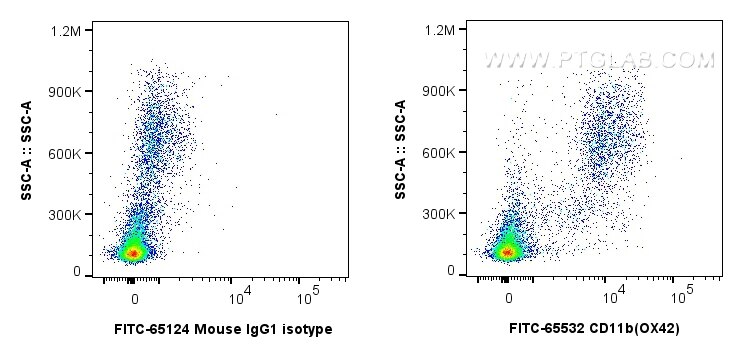Tested Applications
| Positive FC detected in | rat bone marrow cells |
Recommended dilution
| Application | Dilution |
|---|---|
| This reagent has been tested for flow cytometric analysis. It is recommended that this reagent should be titrated in each testing system to obtain optimal results. | |
| Sample-dependent, Check data in validation data gallery. | |
Product Information
FITC-65532 targets CD11b in FC applications and shows reactivity with rat samples.
| Tested Reactivity | rat |
| Host / Isotype | Mouse / IgG1 |
| Class | Recombinant |
| Type | Antibody |
| Immunogen | Rat peritoneal macrophages Predict reactive species |
| Full Name | integrin alpha M |
| Calculated Molecular Weight | 127 kDa |
| GenBank Accession Number | NM_012711 |
| Gene Symbol | CD11b |
| Gene ID (NCBI) | 25021 |
| RRID | AB_3673865 |
| Conjugate | FITC Plus Fluorescent Dye |
| Excitation/Emission Maxima Wavelengths | 495 nm / 524 nm |
| Form | Liquid |
| Purification Method | Affinity purification |
| Storage Buffer | PBS with 0.09% sodium azide. |
| Storage Conditions | Store at 2-8°C. Avoid exposure to light. Stable for one year after shipment. |
Background Information
Integrins are cell adhesion receptors that are heterodimers composed of non-covalently associated α and β subunits (PMID: 9779984). CD11b, also known as Integrin alpha M or CR3A, belongs to the integrin alpha chain family. CD11b forms an α/β heterodimer with CD18 (integrin β2). CD11b/CD18 is implicated in various adhesive interactions of monocytes, macrophages and granulocytes as well as in mediating the uptake of complement-coated particles and pathogens (PMID: 9558116; 20008295). CD11b/CD18 is a receptor for the complement protein fragment iC3b, and is also a receptor for fibrinogen, factor X and ICAM1 (PMID: 2971974; 15485828).
Protocols
| Product Specific Protocols | |
|---|---|
| FC protocol for FITC Plus CD11b antibody FITC-65532 | Download protocol |
| Standard Protocols | |
|---|---|
| Click here to view our Standard Protocols |



